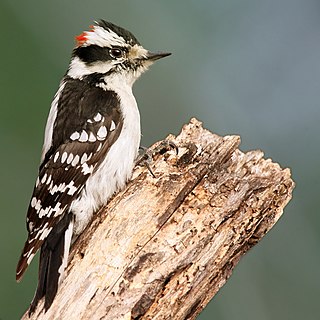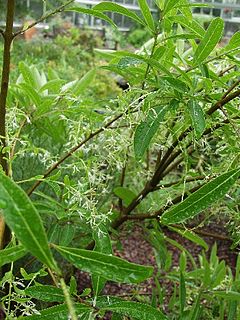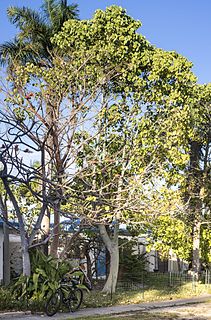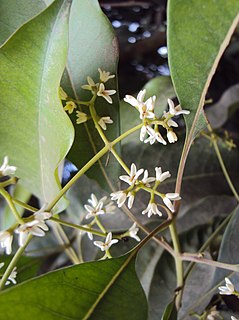
The downy woodpecker is a species of woodpecker, the smallest in North America.
Ironwood is a common name for many woods or plants that have a reputation for hardness, or specifically a wood density that is heavier than water, although usage of the name ironwood in English may or may not indicate a tree that yields such heavy wood.

Betula pendula, commonly known as silver birch, warty birch, European white birch, or East Asian white birch, is a species of tree in the family Betulaceae, native to Europe and parts of Asia, though in southern Europe, it is only found at higher altitudes. Its range extends into Siberia, China, and southwest Asia in the mountains of northern Turkey, the Caucasus, and northern Iran. It has been introduced into North America, where it is known as the European white birch, and is considered invasive in some states in the United States and parts of Canada. The tree can also be found in more temperate regions of Australia.

Betula pubescens, commonly known as downy birch and also as moor birch, white birch, European white birch or hairy birch, is a species of deciduous tree, native and abundant throughout northern Europe and northern Asia, growing farther north than any other broadleaf tree. It is closely related to, and often confused with, the silver birch, but grows in wetter places with heavier soils and poorer drainage; smaller trees can also be confused with the dwarf birch.

Entandrophragma cylindricum is a tree of the genus Entandrophragma of the family Meliaceae. It is commonly known as sapele or sapelli or sapele mahogany, as well as aboudikro, assi, and muyovu.
The Carlisle S. Page Arboretum is an arboretum located within Historic Elmwood Cemetery, 824 South Dudley Street, Memphis, Tennessee.

Quercus faginea, the Portuguese oak, is a species of oak native to the western Mediterranean region in the Iberian Peninsula. Similar trees in the Atlas Mountains of northwest Africa are usually included in this species, or sometimes treated as a distinct species, Quercus tlemcenensis. It occurs in mountains from sea level to 1900 m altitude, and flourishes in a variety of soils and climates. Out of all the oak forests in the Iberian Peninsula, the southern populations of Portuguese oak were found to have the highest diversity and endemism of spider species.

Chionanthus, common name: fringetrees, is a genus of about 150 species of flowering plants in the family Oleaceae.

Chionanthus virginicus is a tree native to the savannas and lowlands of the southeastern United States, from New Jersey south to Florida, and west to Oklahoma and Texas.

Hildegardia populifolia is a species of flowering plant in the family Malvaceae. It is found only in the Eastern Ghats of Andhra Pradesh and Tamil Nadu in India. It is threatened by habitat loss; just about 20 trees are known to exist on the eastern slopes of the Kalrayan Hills.

Lacistema lucidum is a species of flowering plant in the family Lacistemataceae. It is a small tree or shrub that is endemic to Brazil, where it is known from five states including Pará and São Paulo. It occurs in Atlantic rain forest habitat, and is an uncommon species.
Chionanthus albidiflorus is a species of flowering plant in the family Oleaceae. It is endemic to Sri Lanka.

Chionanthus ramiflorus, commonly known as northern olive or native olive, is a species of shrubs and trees, of the flowering plant family Oleaceae. They grow naturally in India, Nepal, northeastern Australia (Queensland), New Guinea, the Philippines, southern China and Taiwan.

Paulownia kawakamii, commonly known as the sapphire dragon tree, is a tree species in the family Paulowniaceae.
As of July 2016, the International Union for Conservation of Nature (IUCN) lists 238 conservation dependent species. 0.29% of all evaluated species are listed as conservation dependent. The IUCN also lists seven subspecies and five varieties as conservation dependent.
Chionanthus kinabaluensis is a tree in the family Oleaceae.
Chionanthus pluriflorus is a tree in the family Oleaceae. The specific epithet pluriflorus means "many-flowered".
Chionanthus polycephalus is a tree in the family Oleaceae. The specific epithet polycephalus means "many-headed", referring to the inflorescence.
Chionanthus polygamus is a tree in the family Oleaceae. The specific epithet polygamus refers to the tree having both unisexual and bisexual flowers.

Sympistis chionanthi, the grey o moth or fringe-tree sallow, is a moth of the family Noctuidae. The species was first described by James Edward Smith in 1797. It is found from North Dakota to Nova Scotia south to at least to Virginia and Kansas. The habitat consists of deciduous woodlands, including riparian woodlands, but also plantations and farmyard shelterbelts.













